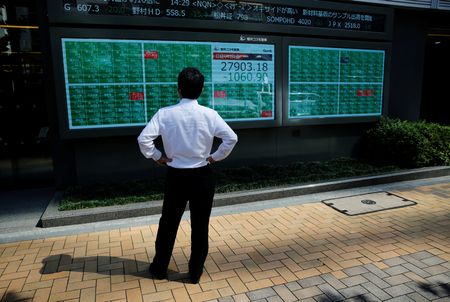
(Corrects paragraph 5 to show the Fed raised rates by 25 bps in February and 50 bps in December)
By Ankur Banerjee
SINGAPORE (Reuters) – Asian shares were on track for their worst day in a month on Wednesday after hawkish comments from Federal Reserve Chair Jerome Powell raised the possibility of the U.S. central bank returning to large rate hikes to tackle sticky inflation.
The Fed will likely need to raise interest rates more than previously expected in response to recent strong data, Powell said on the first day of his semi-annual, two-day monetary policy testimony before Congress.
The comments from Powell sent stocks sharply lower, weighed on gold, while pushing the dollar to its three month high. [/FRX]
MSCI’s broadest index of Asia-Pacific shares outside Japan was 1.69% lower at 514.71, with the downbeat mood set to spill over to Europe as futures indicate a lower open. Eurostoxx 50 futures down 0.19%, German DAX futures down 0.28% and FTSE futures down 0.23%
After a series of jumbo hikes last year, the Fed raised rates by 50 basis points in December and by just 25 basis points at its last meeting in February.
However, resilient economic data since start of this year had stoked fears the U.S. central bank might return to larger rate rises, which Powell acknowledged.
“If the totality of the data were to indicate that faster tightening is warranted, we would be prepared to increase the pace of rate hikes,” Powell said.
Markets are now pricing in an almost 70% chance of a 50 basis point rate hike at the Fed’s March 21-22 policy meeting, according to CME’s FedWatch tool, up from about a 30% a day ago.
“Powell has essentially opened the door to 50 basis point hike,” said Chris Weston, head of research at Pepperstone.
“He has given the Fed optionality, but one suspects he would be loath to do so as it is not a good look to change tactics when you’ve only just moved down to 25 basis points increments.”
In Asia, Powell comments cast a shadow with most markets nursing heavy losses. Australia’s S&P/ASX 200 index fell nearly 1%, while China shares slipped 0.59%. Hong Kong’s Hang Seng Index fell 2.65%, on course for its worst day since late January.
Japan’s Nikkei was the sole stock index in Asia with gains, up nearly 0.5%, as a weakening yen buoyed exporters.
Shorter-term Treasury yields continued its ascent on Wednesday, with the two-year U.S. Treasury yield, which typically moves in step with interest rate expectations, was up 4.9 basis points at 5.060%, having touched fresh near 16 year high of 5.078% earlier in the session.
A closely watched part of the U.S. Treasury yield curve measuring the gap between yields on two- and 10-year Treasury notes, seen as an indicator of economic expectations, was at -107.3 basis points, its deepest since August 1981, according to Refinitiv data. Such an inversion is seen as a reliable recession indicator.
“Given what we already knew, Powell’s hawkish remarks shouldn’t have been a surprise, but evidently the market was not prepared,” said Rodrigo Catril, senior currency strategist at National Australia Bank, adding recent data was signalling the U.S. economy started 2023 on a much stronger footing than most had anticipated.
The spotlight will now be on Friday’s U.S. payrolls data and next week’s inflation figures that will dictate further moves from the Fed.
Citi strategists said even as-expected payrolls and inflation data could keep the chance of a 50 basis point hike high. “Not following through on a 50 bps increase could then entail an unhelpfully large easing of financial conditions.”
In the currency market, the dollar continued its charge, touching three month high. The dollar index, which measures the U.S. currency against six major rivals, was last at 105.77, up 0.114%, after surging 1.3% on Tuesday.
The dollar rose as high as 0.54% against the yen to touch 137.90, its highest since Dec. 15, before easing to trade at 137.67, ahead of the Bank of Japan meeting on Thursday and Friday, when the central bank is expected to stick to its ultra loose monetary policy
The euro slipped 0.11% to $1.0536, pinned near its two-month low. Sterling was last trading at $1.1824, down 0.02% on the day, having touched more than three month low of $1.1812 earlier in the session.
U.S. crude fell 0.12% to $77.49 per barrel and Brent was at $83.34, up 0.06% on the day.
(This story has been corrected to show that the Fed raised rates by 25 bps in February and 50 bps in December, in paragraph 5)
(Reporting by Ankur Banerjee; Editing by Lincoln Feast and Stephen Coates)

